Combined Use of Sentinel-1 SAR and Landsat Sensors Products for Residual Soil Moisture Retrieval over Agricultural Fields in the Upper Blue Nile Basin, Ethiopia
Abstract
1. Introduction
2. Materials and Methods
2.1. Site Description
2.2. Datasets
2.2.1. Remotely Sensed Images
2.2.2. Experimental Ground Measurements
2.3. Methods
2.3.1. Parameterization of Crop Residue Effect
2.3.2. Estimation of Soil Roughness Parameters
2.3.3. Artificial Neural Network (ANN)
3. Results
3.1. Crop Residue Water Content
3.2. The Relation Between Radar Backscattering Coefficient of Bare Soil and Soil Moisture.
3.3. Estimating Surface Roughness Parameters
3.4. Soil Moisture Estimation
4. Discussion
5. Conclusions
Author Contributions
Funding
Acknowledgments
Conflicts of Interest
References
- Taffesse, A.S.; Dorosh, P.; Gemessa, S.A. 3 Crop Production in Ethiopia: Regional Patterns and Trends. In Food and Agriculture in Ethiopia; University of Pennsylvania Press: Philadelphia, PA, USA, 2014. [Google Scholar]
- Conway, D. The Climate and Hydrology of the Upper Blue Nile River. Geogr. J. 2000, 166, 49–62. [Google Scholar] [CrossRef]
- Engida, A.N.; Esteves, M. Characterization and disaggregation of daily rainfall in the Upper Blue Nile Basin in Ethiopia. J. Hydrol. 2011, 399, 226–234. [Google Scholar] [CrossRef]
- Gillies, R.R.; Carlson, T.N. Thermal Remote Sensing of Surface Soil Water Content with Partial Vegetation Cover for Incorporation into Climate Models. J. Appl. Meteorol. 1995, 34, 745–756. [Google Scholar] [CrossRef]
- Sandholt, I.; Rasmussen, K.; Andersen, J. A simple interpretation of the surface temperature/vegetation index space for assessment of surface moisture status. Remote. Sens. Environ. 2002, 79, 213–224. [Google Scholar] [CrossRef]
- Petropoulos, G.P.; Ireland, G.; Petropoulos, G.P.; Ireland, G.; Barrett, B. Surface soil moisture retrievals from remote sensing: Current status, products & future trends. Phys. Chem. Earth Parts A/B/C 2015, 83–84, 36–56. [Google Scholar]
- Ulaby, F.T.; Bradley, G.A.; Dobson, M.C. Microwave Backscatter Dependence on Surface Roughness, Soil Moisture, and Soil Texture: Part II-Vegetation-Covered Soil. IEEE Trans. Geosci. Electron. 1979, 17, 33–40. [Google Scholar] [CrossRef]
- Zribi, M.; Baghdadi, N.; Holah, N.; Fafin, O. New methodology for soil surface moisture estimation and its application to ENVISAT-ASAR multi-incidence data inversion. Remote. Sens. Environ. 2005, 96, 485–496. [Google Scholar] [CrossRef]
- Amazirh, A.; Merlin, O.; Er-Raki, S.; Gao, Q.; Vincent, R.; Malbeteau, Y.; Khabba, S.; Escorihuela, M.J. Retrieving surface soil moisture at high spatio-temporal resolution from a synergy between Sentinel-1 radar and Landsat thermal data: A study case over bare soil. Remote. Sens. Environ. 2018, 211, 321–337. [Google Scholar] [CrossRef]
- Bai, X.; He, B.; Li, X.; Zeng, J.; Wang, X.; Wang, Z.; Zeng, Y.; Su, Z. First Assessment of Sentinel-1A Data for Surface Soil Moisture Estimations Using a Coupled Water Cloud Model and Advanced Integral Equation Model over the Tibetan Plateau. Remote. Sens. 2017, 9, 714. [Google Scholar] [CrossRef]
- Torres, R.; Snoeij, P.; Geudtner, D.; Bibby, D.; Davidson, M.; Attema, E.; Potin, P.; Rommen, B.; Floury, N.; Brown, M.; et al. GMES Sentinel-1 mission. Remote. Sens. Environ. 2012, 120, 9–24. [Google Scholar] [CrossRef]
- Ulaby, F.T.; Batlivala, P.P.; Dobson, M.C. Microwave Backscatter Dependence on Surface Roughness, Soil Moisture, and Soil Texture: Part I-Bare Soil. IEEE Trans. Geosci. Electron. 1978, 16, 286–295. [Google Scholar] [CrossRef]
- Dobson, M.C.; Ulaby, F. Microwave Backscatter Dependence on Surface Roughness, Soil Moisture, And Soil Texture: Part III-Soil Tension. IEEE Trans. Geosci. Remote. Sens. 1981, 19, 51–61. [Google Scholar] [CrossRef]
- Karthikeyan, L.; Pan, M.; Wanders, N.; Kumar, D.N.; Wood, E.F. Four decades of microwave satellite soil moisture observations: Part 1. A review of retrieval algorithms. Adv. Water Resour. 2017, 109, 106–120. [Google Scholar] [CrossRef]
- Oh, Y.; Sarabandi, K.; Ulaby, F. An empirical model and an inversion technique for radar scattering from bare soil surfaces. IEEE Trans. Geosci. Remote. Sens. 1992, 30, 370–381. [Google Scholar] [CrossRef]
- Oh, Y.; Sarabandi, K.; Ulaby, F. Semi-empirical model of the ensemble-averaged differential Mueller matrix for microwave backscattering from bare soil surfaces. IEEE Trans. Geosci. Remote. Sens. 2002, 40, 1348–1355. [Google Scholar] [CrossRef]
- Oh, Y. Quantitative Retrieval of Soil Moisture Content and Surface Roughness From Multi-polarized Radar Observations of Bare Soil Surfaces. IEEE Trans. Geosci. Remote. Sens. 2004, 42, 596–601. [Google Scholar] [CrossRef]
- Dubois, P.; Van Zyl, J.; Engman, T. Measuring soil moisture with imaging radars. IEEE Trans. Geosci. Remote. Sens. 1995, 33, 915–926. [Google Scholar] [CrossRef]
- Fung, A.; Li, Z.; Chen, K. Backscattering from a randomly rough dielectric surface. IEEE Trans. Geosci. Remote. Sens. 1992, 30, 356–369. [Google Scholar] [CrossRef]
- Choker, M.; Baghdadi, N.; Zribi, M.; El Hajj, M.; Paloscia, S.; Verhoest, N.; Lievens, H.; Mattia, F. Evaluation of the Oh, Dubois and IEM models using large dataset of SAR signal and experimental soil measurements. Water 2017, 9, 38. [Google Scholar] [CrossRef]
- Baghdadi, N.; Choker, M.; Zribi, M.; El Hajj, M.; Paloscia, S.; Verhoest, N.E.C.; Lievens, H.; Baup, F.; Mattia, F. A New Empirical Model for Radar Scattering from Bare Soil Surfaces. Remote. Sens. 2016, 8, 920. [Google Scholar] [CrossRef]
- Bindlish, R.; Barros, A. Parameterization of vegetation backscatter in radar-based, soil moisture estimation. Remote. Sens. Environ. 2001, 76, 130–137. [Google Scholar] [CrossRef]
- Meng, Q.; Zhang, L.; Xie, Q.; Yao, S.; Chen, X.; Zhang, Y. Combined Use of GF-3 and Landsat-8 Satellite Data for Soil Moisture Retrieval over Agricultural Areas Using Artificial Neural Network. Adv. Meteorol. 2018, 2018, 1–11. [Google Scholar] [CrossRef]
- Liu, C.; Shi, J. Estimation of vegetation parameters of water cloud model for global soil moisture retrieval using time-series L-band Aquarius observations. IEEE J. Appl. Earth Obs. Remote. Sens. 2006, 9, 5621–5633. [Google Scholar] [CrossRef]
- Huang, S.; Ding, J.; Zou, J.; Liu, B.; Zhang, J.; Chen, W. Soil Moisture Retrival Based on Sentinel-1 Imagery under Sparse Vegetation Coverage. Sensors 2019, 19, 589. [Google Scholar] [CrossRef] [PubMed]
- Baghdadi, N.; El Hajj, M.M.; Zribi, M.; Bousbih, S. Calibration of the Water Cloud Model at C-Band for Winter Crop Fields and Grasslands. Remote. Sens. 2017, 9, 969. [Google Scholar] [CrossRef]
- El Hajj, M.; Baghdadi, N.; Zribi, M.; Belaud, G.; Cheviron, B.; Courault, D.; Charron, F. Soil moisture retrieval over irrigated grassland using X-band SAR data. Remote. Sens. Environ. 2016, 176, 202–218. [Google Scholar] [CrossRef]
- Mirsoleimani, H.R.; Sahebi, M.R.; Baghdadi, N.; El Hajj, M.M. Bare Soil Surface Moisture Retrieval from Sentinel-1 SAR Data Based on the Calibrated IEM and Dubois Models Using Neural Networks. Sensors 2019, 19, 3209. [Google Scholar] [CrossRef]
- Bousbih, S.; Zribi, M.; El Hajj, M.M.; Baghdadi, N.; Chabaane, Z.L.; Gao, Q.; Fanise, P. Soil Moisture and Irrigation Mapping in A Semi-Arid Region, Based on the Synergetic Use of Sentinel-1 and Sentinel-2 Data. Remote. Sens. 2018, 10, 1953. [Google Scholar] [CrossRef]
- El Hajj, M.M.; Baghdadi, N.; Zribi, M.; Bazzi, H. Synergic Use of Sentinel-1 and Sentinel-2 Images for Operational Soil Moisture Mapping at High Spatial Resolution over Agricultural Areas. Remote. Sens. 2017, 9, 1292. [Google Scholar] [CrossRef]
- Gao, Q.; Zribi, M.; Escorihuela, M.J.; Baghdadi, N. Synergetic Use of Sentinel-1 and Sentinel-2 Data for Soil Moisture Mapping at 100 m Resolution. Sensors 2017, 17, 1966. [Google Scholar] [CrossRef]
- Baghdadi, N.; El Hajj, M.M.; Zribi, M. Coupling SAR C-band and optical data for soil moisture and leaf area index retrieval over irrigated grasslands. IEEE Int. Geosci. Remote Sens. Symp. (IGARSS) 2016, 9, 3551–3554. [Google Scholar] [CrossRef]
- Gorrab, A.; Zribi, M.; Baghdadi, N.; Mougenot, B.; Fanise, P.; Chabaane, Z.L. Retrieval of Both Soil Moisture and Texture Using TerraSAR-X Images. Remote. Sens. 2015, 7, 10098–10116. [Google Scholar] [CrossRef]
- El Hajj, M.M.; Baghdadi, N.; Belaud, G.; Zribi, M.; Cheviron, B.; Courault, D.; Hagolle, O.; Charron, F. Irrigated Grassland Monitoring Using a Time Series of TerraSAR-X and COSMO-SkyMed X-Band SAR Data. Remote. Sens. 2014, 6, 10002–10032. [Google Scholar] [CrossRef]
- Baghdadi, N.; Aubert, M.; Zribi, M. Use of TerraSAR-X Data to Retrieve Soil Moisture Over Bare Soil Agricultural Fields. IEEE Geosci. Remote. Sens. Lett. 2012, 9, 512–516. [Google Scholar] [CrossRef]
- Kim, S.-B.; Moghaddam, M.; Tsang, L.; Burgin, M.; Xu, X.; Njoku, E.G. Models of L-Band Radar Backscattering Coefficients Over Global Terrain for Soil Moisture Retrieval. IEEE Trans. Geosci. Remote. Sens. 2013, 52, 1381–1396. [Google Scholar] [CrossRef]
- Balenzano, A.; Satalino, G.; Lovergine, F.; Rinaldi, M.; Iacobellis, V.; Mastronardi, N.; Mattia, F. On the use of temporal series of L-and X-band SAR data for soil moisture retrieval. Capitanata plain case study. Eur. J. Remote Sens. 2013, 46, 721–737. [Google Scholar] [CrossRef]
- El Hajj, M.M.; Baghdadi, N.; Zribi, M. Comparative analysis of the accuracy of surface soil moisture estimation from the C- and L-bands. Int. J. Appl. Earth Obs. Geoinf. 2019, 82, 101888. [Google Scholar] [CrossRef]
- Zribi, M.; Chahbi, A.; Shabou, M.; Chabaane, Z.L.; Duchemin, B.; Baghdadi, N.; Amri, R.; Chehbouni, A. Soil surface moisture estimation over a semi-arid region using ENVISAT ASAR radar data for soil evaporation evaluation. Hydrol. Earth Syst. Sci. 2011, 15, 345–358. [Google Scholar] [CrossRef]
- He, B.; Xing, M.; Bai, X. A Synergistic Methodology for Soil Moisture Estimation in an Alpine Prairie Using Radar and Optical Satellite Data. Remote. Sens. 2014, 6, 10966–10985. [Google Scholar] [CrossRef]
- Tomer, S.K.; Al Bitar, A.; Sekhar, M.; Zribi, M.; Bandyopadhyay, S.; Sreelash, K.; Sharma, A.K.; Corgne, S.; Kerr, Y. Retrieval and Multi-scale Validation of Soil Moisture from Multi-temporal SAR Data in a Semi-Arid Tropical Region. Remote. Sens. 2015, 7, 8128–8153. [Google Scholar] [CrossRef]
- Alexakis, D.D.; Mexis, F.-D.K.; Vozinaki, A.-E.K.; Daliakopoulos, I.N.; Tsanis, I. Soil Moisture Content Estimation Based on Sentinel-1 and Auxiliary Earth Observation Products. A Hydrological Approach. Sensors 2017, 17, 1455. [Google Scholar] [CrossRef]
- Zribi, M.; Taconet, O.; Le Hégarat-Mascle, S.; Vidal-Madjar, D.; Emblanch, C.; Loumagne, C.; Normand, M. Backscattering behavior and simulation comparison over bare soils using SIR-C/X-SAR and ERASME 1994 data over Orgeval. Remote. Sens. Environ. 1997, 59, 256–266. [Google Scholar] [CrossRef]
- Altese, E.; Bolognani, O.; Troch, P.A.; Mancini, M. Retrieving Soil Moisture Over Bare Soil from ERS 1 Synthetic Aperture Radar Data: Sensitivity Analysis Based on a Theoretical Surface Scattering Model and Field Data. Water Resour. Res. 1996, 32, 653–661. [Google Scholar] [CrossRef]
- Davidson, M.; Le Toan, T.; Mattia, F.; Satalino, G.; Manninen, T.; Borgeaud, M. On the characterization of agricultural soil roughness for radar remote sensing studies. IEEE Trans. Geosci. Remote. Sens. 2000, 38, 630–640. [Google Scholar] [CrossRef]
- Baghdadi, N.; King, C.; Chanzy, A.; Wigneron, J.P. An empirical calibration of the integral equation modelbased on SAR data, soil moisture and surface roughness measurement over bare soils. Int. J. Remote Sens. 2002, 23, 4325–4340. [Google Scholar] [CrossRef]
- Baghdadi, N.; Gherboudj, I.; Zribi, M.; Sahebi, M.; King, C.; Bonn, F. Semi-empirical calibration of the IEM backscattering model using radar images and moisture and roughness field measurements. Int. J. Remote. Sens. 2004, 25, 3593–3623. [Google Scholar] [CrossRef]
- Baghdadi, N.; Holah, N.; Zribi, M. Calibration of the Integral Equation Model for SAR data in C-band and HH and VV polarizations. Int. J. Remote. Sens. 2006, 27, 805–816. [Google Scholar] [CrossRef]
- Álvarez-Mozos, J.; González-Audícana, M.; Casali, J. Evaluation of empirical and semi-empirical backscattering models for surface soil moisture estimation. Can. J. Remote. Sens. 2007, 33, 176–188. [Google Scholar] [CrossRef]
- Gorrab, A.; Zribi, M.; Baghdadi, N.; Mougenot, B.; Chabaane, Z.L. Potential of X-Band TerraSAR-X and COSMO-SkyMed SAR Data for the Assessment of Physical Soil Parameters. Remote. Sens. 2015, 7, 747–766. [Google Scholar] [CrossRef]
- Dawson, M.; Fung, A.; Manry, M. A robust statistical-based estimator for soil moisture retrieval from radar measurements. IEEE Trans. Geosci. Remote. Sens. 1997, 35, 57–67. [Google Scholar] [CrossRef]
- Chang, D. Estimation of Soil Physical Properties Using Remote Sensing and Artificial Neural Network. Remote. Sens. Environ. 2000, 74, 534–544. [Google Scholar] [CrossRef]
- Hornik, K.; Stinchcombe, M.; White, H. Multilayer feed forward networks are universal approximators. Neural Netw. 1989, 2, 259–366. [Google Scholar] [CrossRef]
- Baghdadi, N.; Cresson, R.; El Hajj, M.; Ludwig, R.; La Jeunesse, I. Estimation of soil parameters over bare agriculture areas from C-band polarimetric SAR data using neural networks. Hydrol. Earth Syst. Sci. 2012, 16, 1607–1621. [Google Scholar] [CrossRef]
- Prasad, R.; Pandey, A.; Singh, K.; Singh, V.; Mishra, R.; Singh, D. Retrieval of spinach crop parameters by microwave remote sensing with back propagation artificial neural networks: A comparison of different transfer functions. Adv. Space Res. 2012, 50, 363–370. [Google Scholar] [CrossRef]
- Satalino, G.; Mattia, F.; Davidson, M.; Le Toan, T.; Pasquariello, G.; Borgeaud, M. On current limits of soil moisture retrieval from ERS-SAR data. IEEE Trans. Geosci. Remote Sens. 2002, 40, 2438–2447. [Google Scholar] [CrossRef]
- Santi, E.; Paloscia, S.; Pettinato, S.; Notarnicola, C.; Pasolli, L.; Pistocchi, A. Comparison between SAR Soil Moisture Estimates and Hydrological Model Simulations over the Scrivia Test Site. Remote. Sens. 2013, 5, 4961–4976. [Google Scholar] [CrossRef]
- Paloscia, S.; Pampaloni, P.; Pettinato, S.; Santi, E. A Comparison of Algorithms for Retrieving Soil Moisture from ENVISAT/ASAR Images. IEEE Trans. Geosci. Remote. Sens. 2008, 46, 3274–3284. [Google Scholar] [CrossRef]
- Lakhankar, T.; Ghedira, H.; Temimi, M.; Sengupta, M.; Khanbilvardi, R.; Blake, R. Non-parametric Methods for Soil Moisture Retrieval from Satellite Remote Sensing Data. Remote. Sens. 2009, 1, 3–21. [Google Scholar] [CrossRef]
- Hossain, A.A.; Easson, G. Soil Moisture Estimation in South-Eastern New Mexico Using High Resolution Synthetic Aperture Radar (SAR) Data. Geosciences 2016, 6, 1. [Google Scholar] [CrossRef]
- Kaojarern, S.; Le Toan, T.; Davidson, M.W.J. Monitoring Surface Soil Moisture in Post-Harvest Rice Areas Using C-band Radar Imagery in Northeast Thailand. Geocarto Int. 2004, 19, 61–71. [Google Scholar] [CrossRef]
- McNairn, H.; Duguay, C.; Boisvert, J.B.; Huffman, E.; Brisco, B. Defining the Sensitivity of Multi-frequency and Multi-polarized Radar Backscatter to Post-Harvest Crop Residue. Can. J. Remote Sens. 2001, 27, 247. [Google Scholar] [CrossRef]
- Liu, Z.; Li, P.; Yang, J. Soil Moisture Retrieval and Spatiotemporal Pattern Analysis Using Sentinel-1 Data of Dahra, Senegal. Remote. Sens. 2017, 9, 1197. [Google Scholar] [CrossRef]
- European Space Agency website. Available online: https://scihub.copernicus.eu/dhus/#/home (accessed on 4 August 2017).
- Sentinel-1 Team. Sentinel-1 user handbook. 2013. Available online: http://doi.org/GMES-S1op-EOPG-TN-13-0001 (accessed on 4 August 2017).
- United States Geological Survey (USGS) website. Available online: http://earthexplorer.usgs.gov/ (accessed on 4 August 2017).
- Smith, A.; Major, D. Radar Backscatter and Crop Residues. Can. J. Remote. Sens. 1996, 22, 243–247. [Google Scholar] [CrossRef]
- Yilmaz, M.T.; Hunt, E.R.; Jackson, T.J. Remote sensing of vegetation water content from equivalent water thickness using satellite imagery. Remote. Sens. Environ. 2008, 112, 2514–2522. [Google Scholar] [CrossRef]
- Pause, M.; Volk, M.; Schulz, K. Radar-based surface soil moisture retrieval over agricultural used sites—A multi-sensor approach. In Proceedings of the 4th International Congress on Environmental Modelling and Software, Barcelona, Spain, 7–10 July 2008; 199. [Google Scholar]
- Attema, E.P.W.; Ulaby, F.T. Vegetation modeled as a water cloud. Radio Sci. 1978, 13, 357–364. [Google Scholar] [CrossRef]
- Joseph, A.T.; Van Der Velde, R.; O’Neill, P.E.; Lang, R.; Gish, T. Effects of corn on C- and L-band radar backscatter: A correction method for soil moisture retrieval. Remote. Sens. Environ. 2010, 114, 2417–2430. [Google Scholar] [CrossRef]
- Chai, X.; Zhang, T.; Shao, Y.; Gong, H.; Liu, L.; Xie, K. Modeling and Mapping Soil Moisture of Plateau Pasture Using RADARSAT-2 Imagery. Remote. Sens. 2015, 7, 1279–1299. [Google Scholar] [CrossRef]
- Serrano, L. Deriving Water Content of Chaparral Vegetation from AVIRIS Data. Remote. Sens. Environ. 2000, 74, 570–581. [Google Scholar] [CrossRef]
- Gao, B.-C. NDWI—A normalized difference water index for remote sensing of vegetation liquid water from space. Remote. Sens. Environ. 1996, 58, 257–266. [Google Scholar] [CrossRef]
- Tong, S.S.; DeRoin, J.P.; Pham, T.L.; Cao, X.C. Estimation of Surface Parameters of Tidal Flats Using Sentinel-1A SAR Data in the Northern Coast of Vietnam. In Advances and Applications in Geospatial Technology and Earth Resources; Tien, B.D., Ngoc, D.A., Bui, H.B., Hoang, N.D., Eds.; Springer: Cham, Switzerland, 2017; pp. 65–88. [Google Scholar]
- Ali, I.; Greifeneder, F.; Stamenković, J.; Neumann, M.; Notarnicola, C. Review of Machine Learning Approaches for Biomass and Soil Moisture Retrievals from Remote Sensing Data. Remote. Sens. 2015, 7, 16398–16421. [Google Scholar] [CrossRef]
- Chai, S.S.; Veenendaal, B.; West, G.; Walker, J.P. Back propagation neural network for soil moisture retrieval using NAFE’05 data: A comparison of different training algorithms. Int. Arch. Photogramm. Remote Sens. Spatial Inf. Sci. 2008, 37, 1345. [Google Scholar]
- Haykin, S. Neural Networks a Comprehensive Foundation, 2nd ed.; Pearson Education: Singapore, 1999; pp. 1–823. [Google Scholar]
- Verhoest, N.E.C.; Lievens, H.; Wagner, W.; Álvarez-Mozos, J.; Moran, M.S.; Mattia, F. On the Soil Roughness Parameterization Problem in Soil Moisture Retrieval of Bare Surfaces from Synthetic Aperture Radar. Sensors 2008, 8, 4213–4248. [Google Scholar] [CrossRef] [PubMed]
- Holah, N.; Baghdadi, N.; Zribi, M.; Bruand, A.; King, C. Potential of ASAR/ENVISAT for the characterization of soil surface parameters over bare agricultural fields. Remote. Sens. Environ. 2005, 96, 78–86. [Google Scholar] [CrossRef]
- Le Morvan, A.; Zribi, M.; Baghdadi, N.; Chanzy, A. Soil Moisture Profile Effect on Radar Signal Measurement. Sensors 2008, 8, 256–270. [Google Scholar] [CrossRef]
- Ahmad, S.; Kalra, A.; Stephen, H. Estimating soil moisture using remote sensing data: A machine learning approach. Adv. Water Resour. 2010, 33, 69–80. [Google Scholar] [CrossRef]
- Brogioni, M.; Paloscia, S.; Pampaloni, P.; Pettinato, S.; Santi, E. Soil moisture maps of agricultural fields in Northern Italy from ENVISAT/ASAR images. In Proceedings of the 5th International Symposium on Retrieval of Bio- and Geophysical Parameters from SAR Data for Land Applications, Bari, Italy, 25–28 September 2007. [Google Scholar]
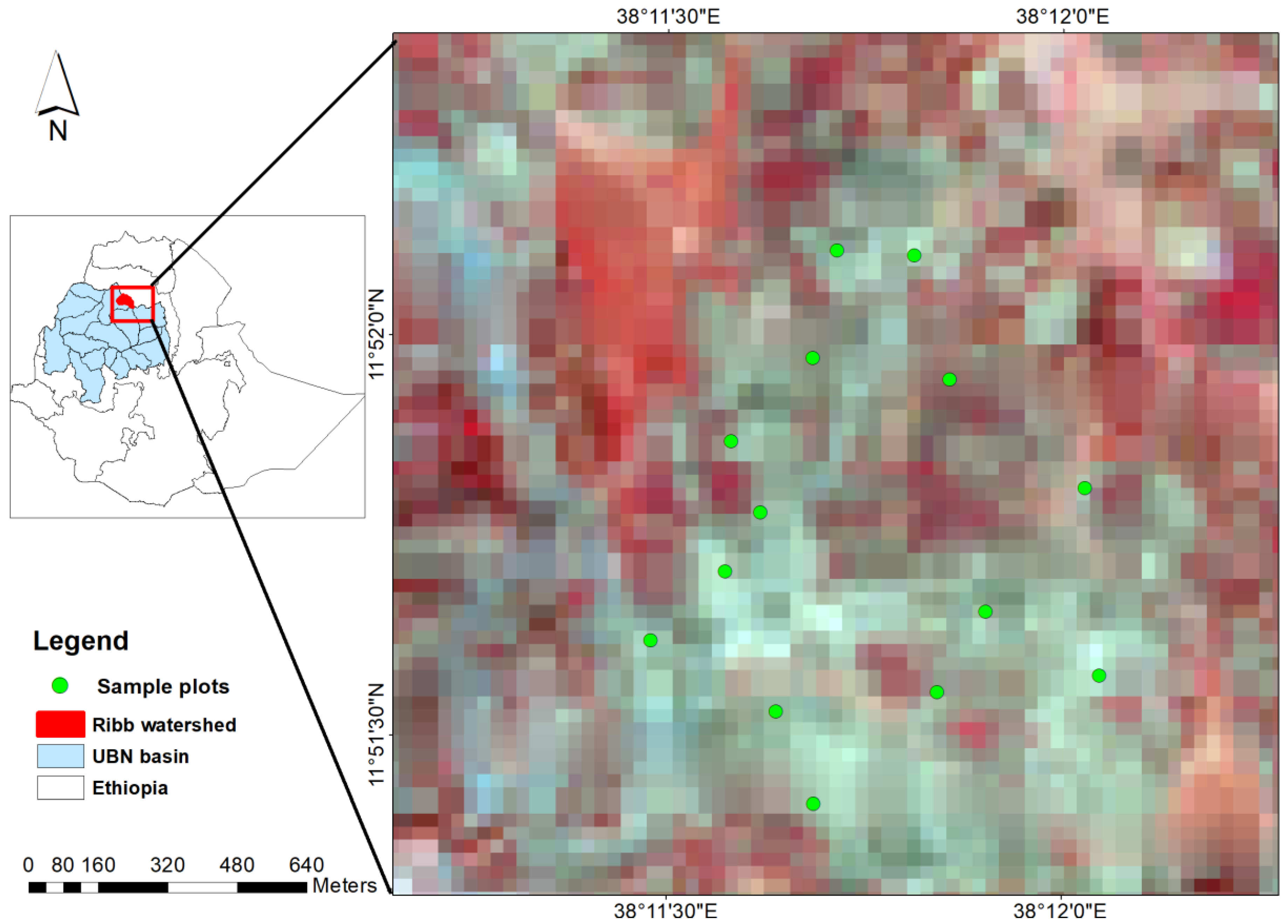
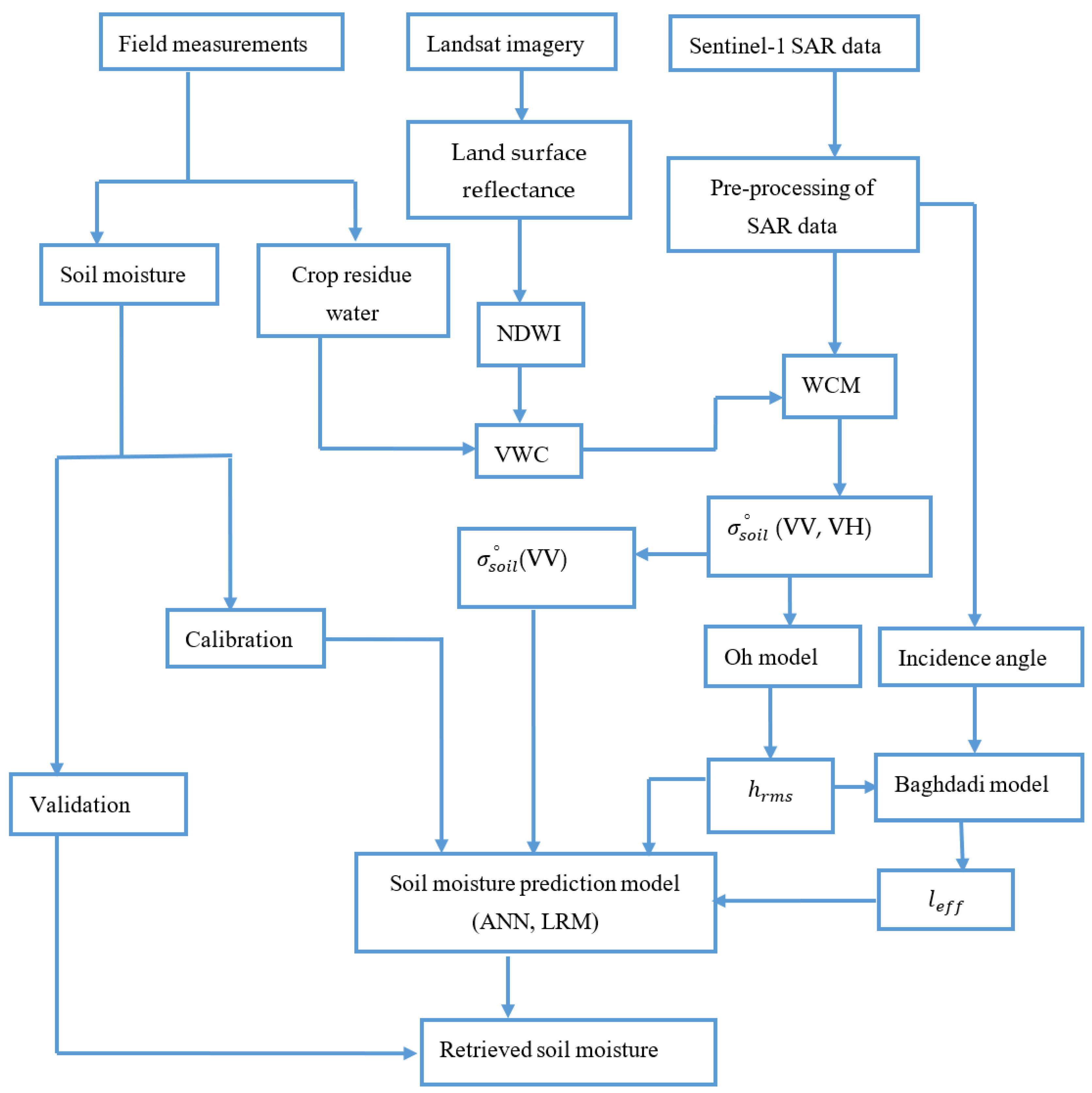
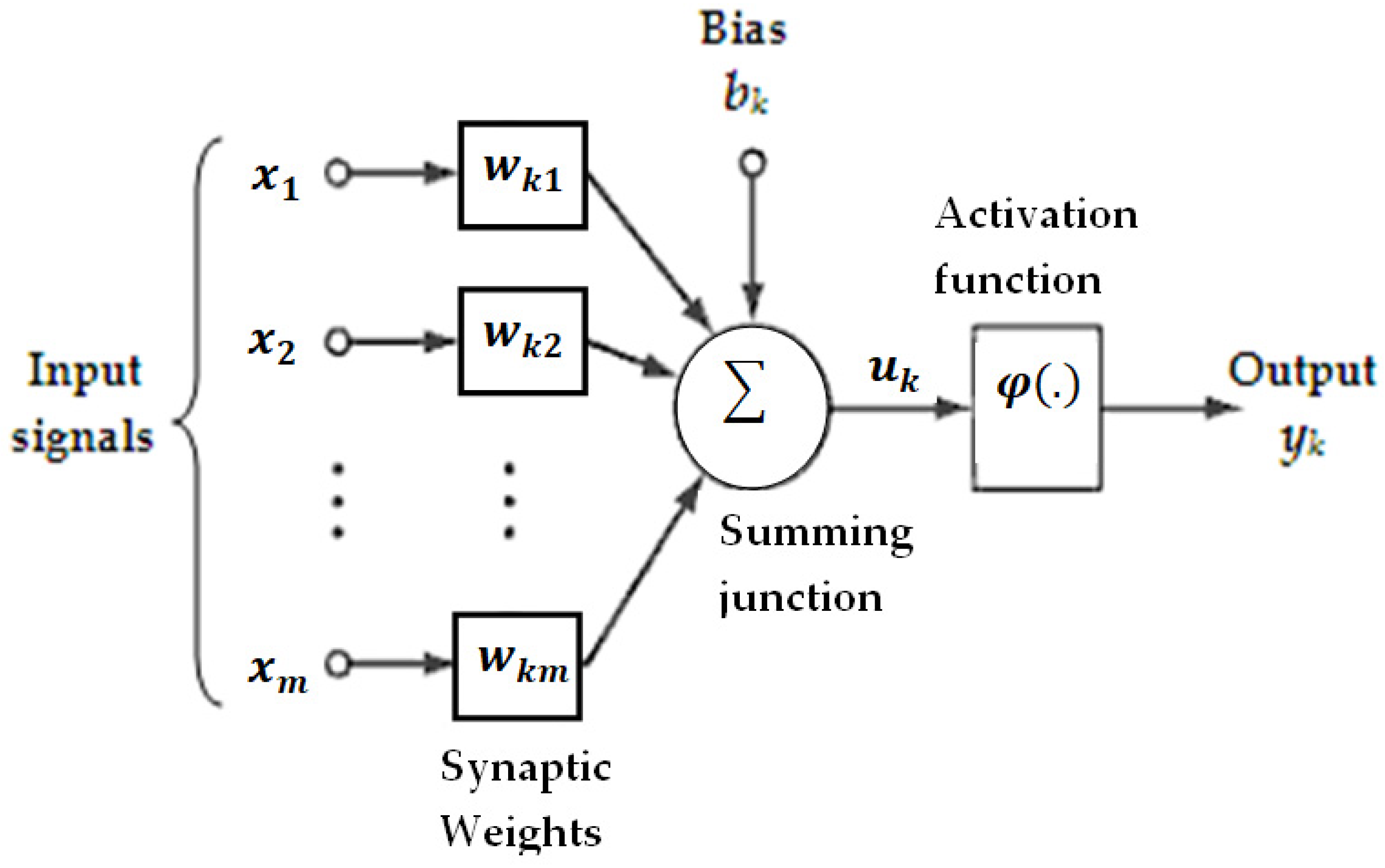
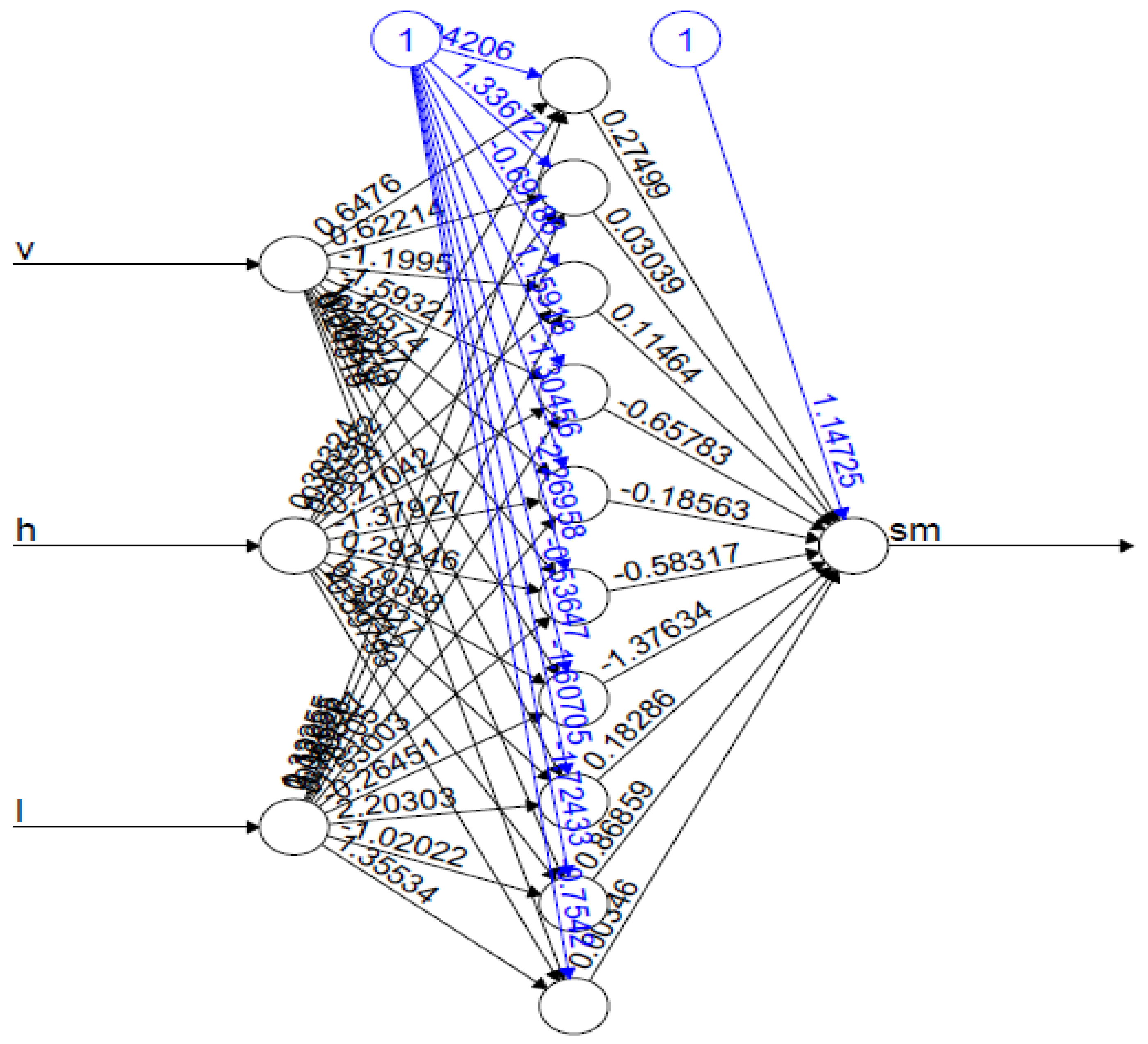
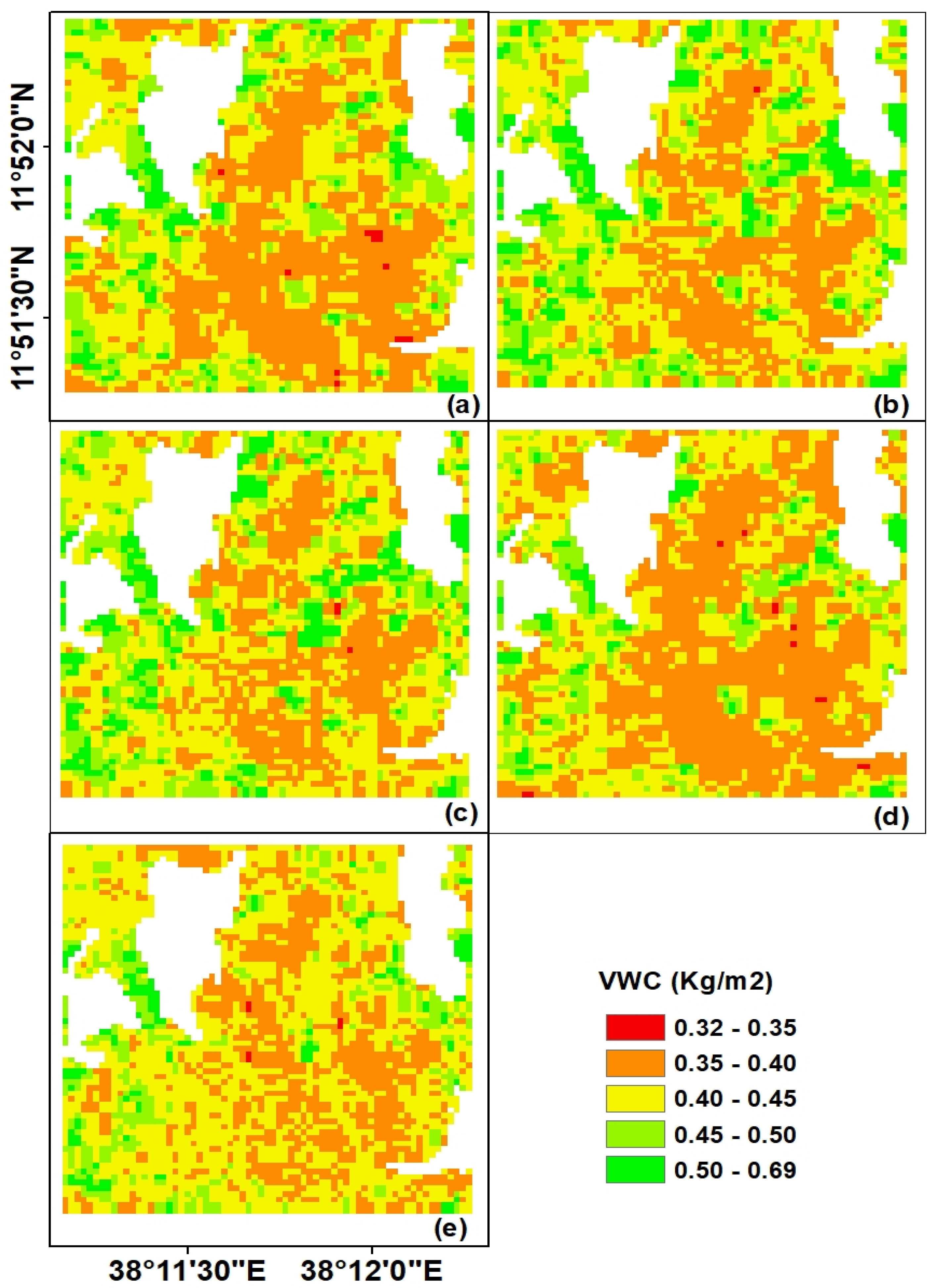
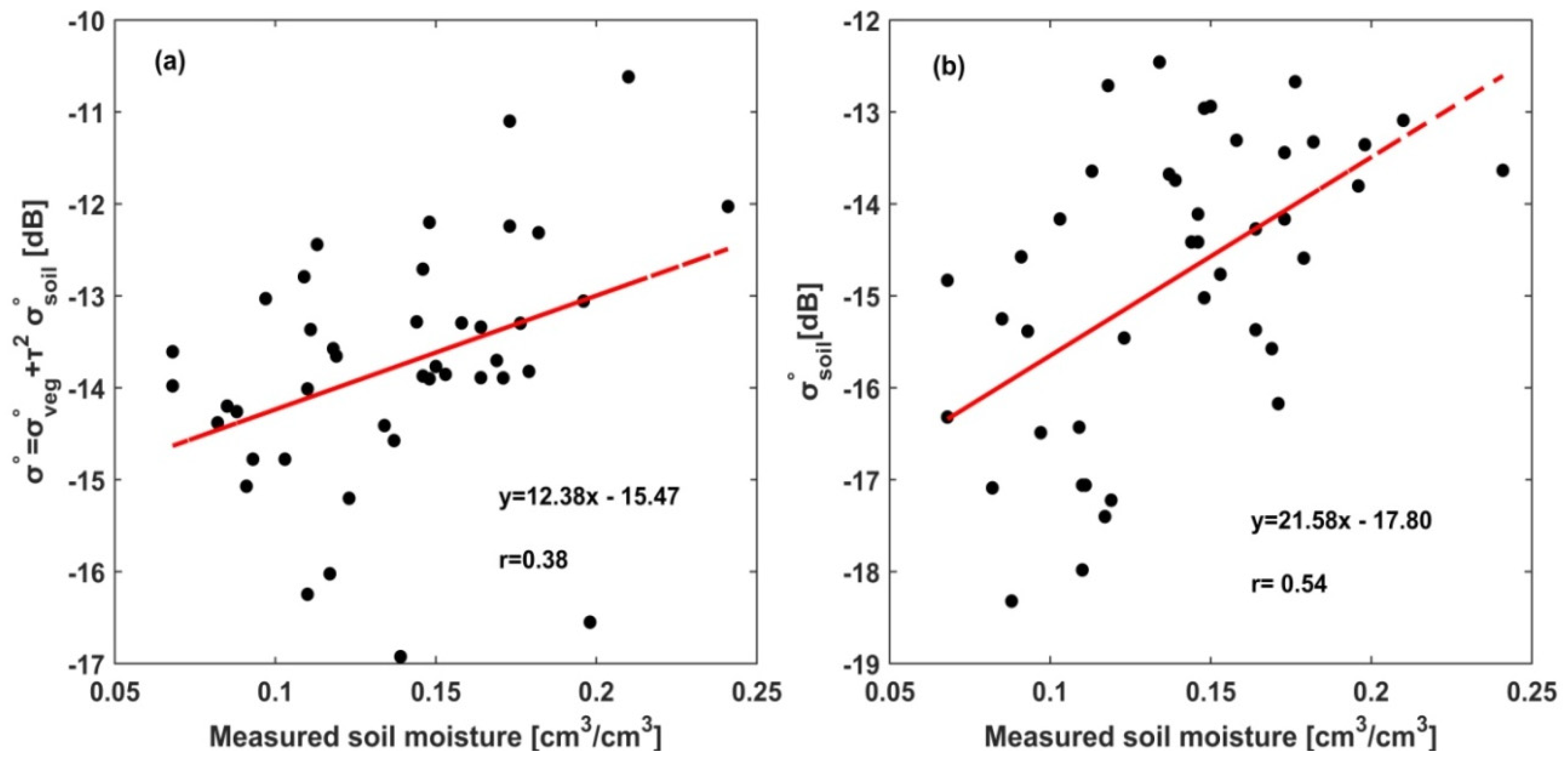
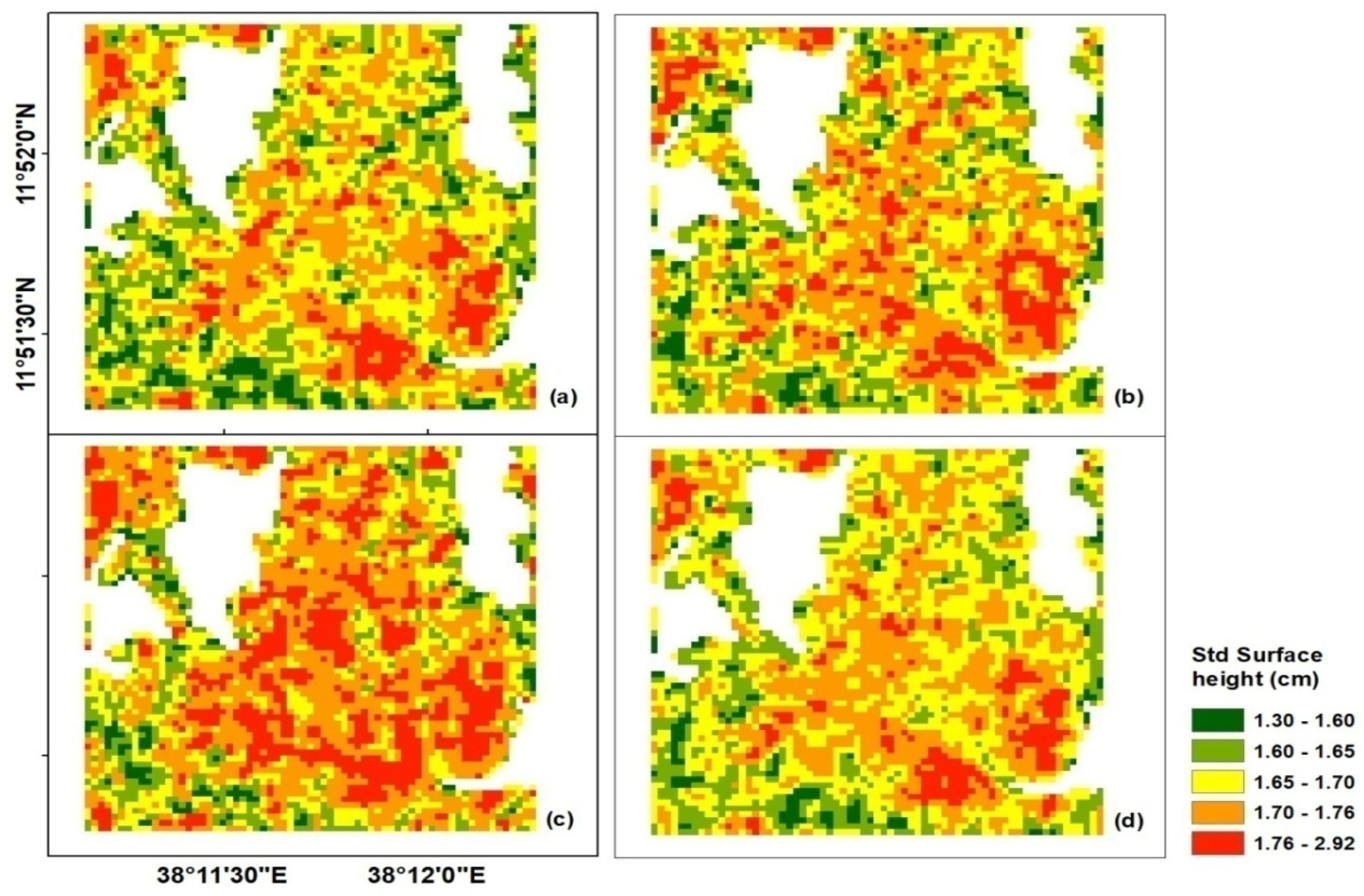
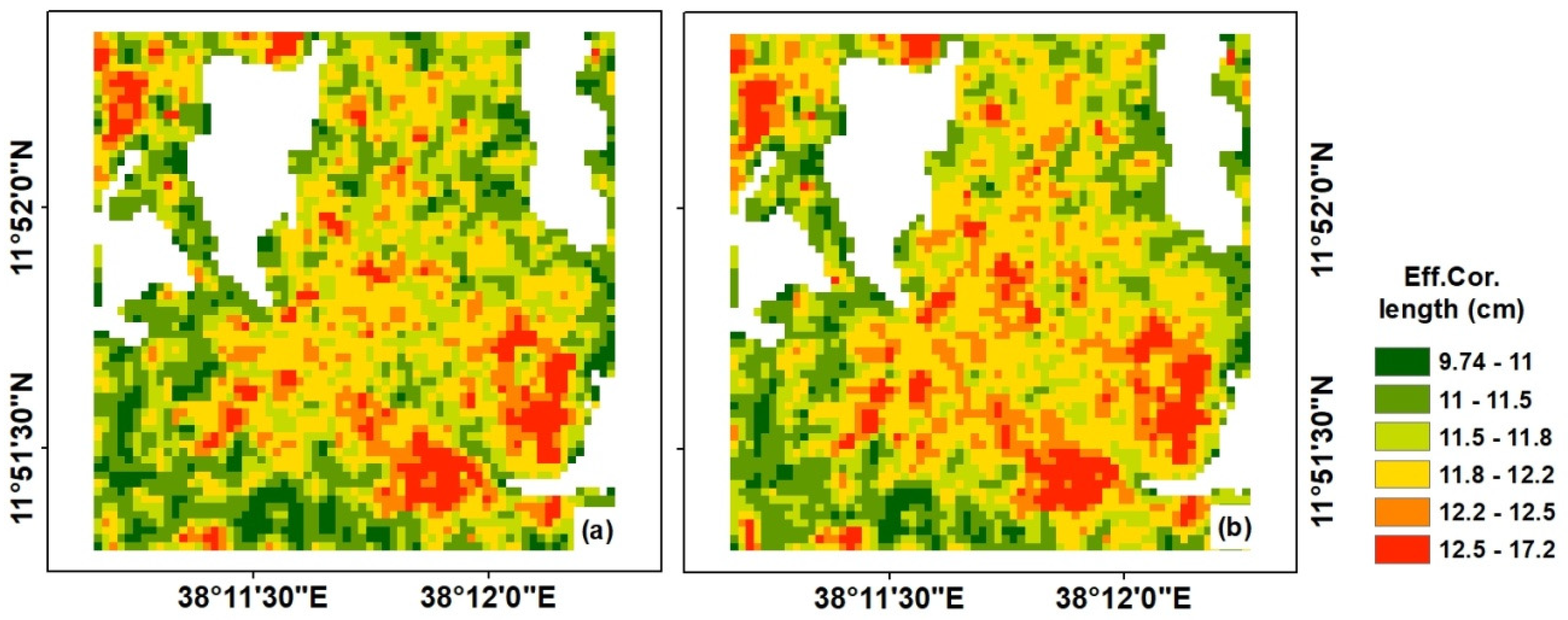
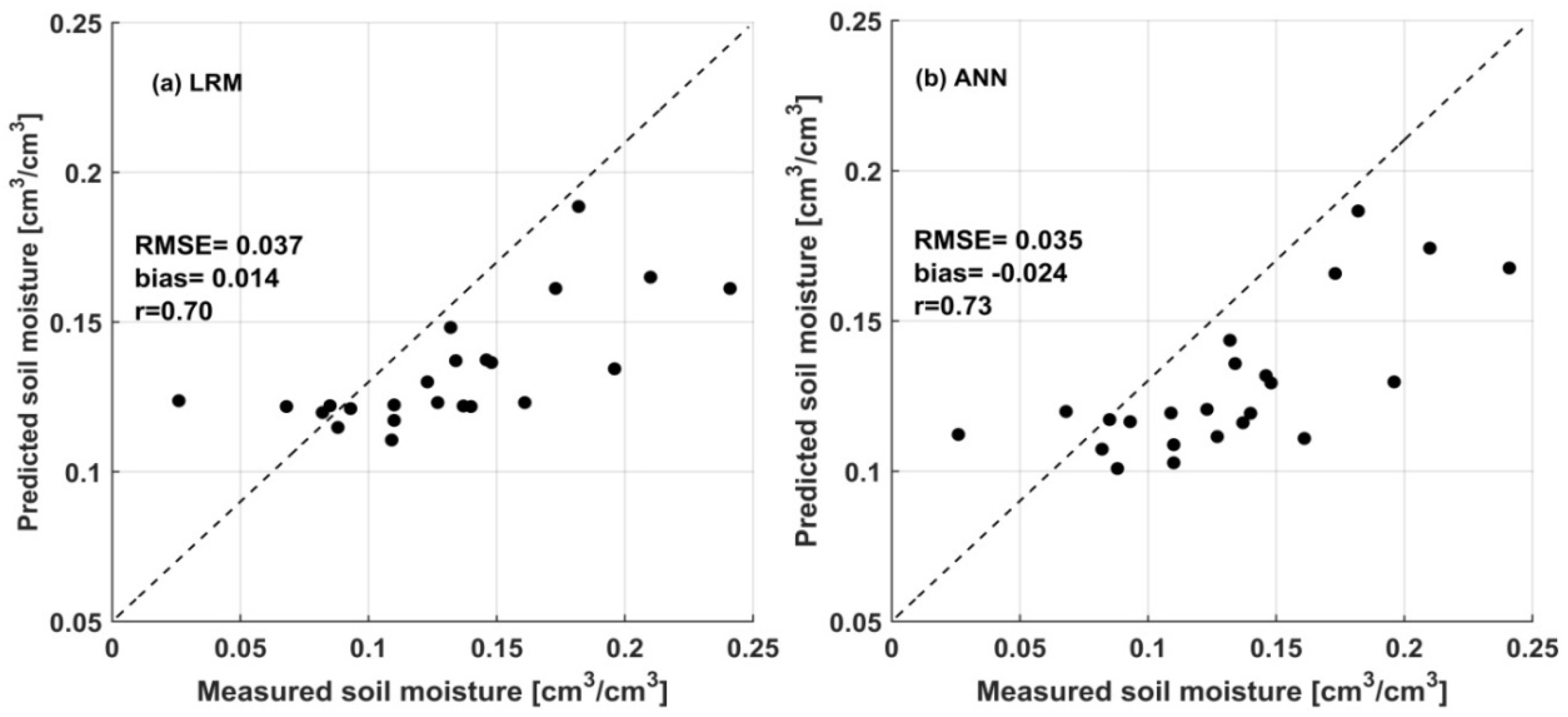
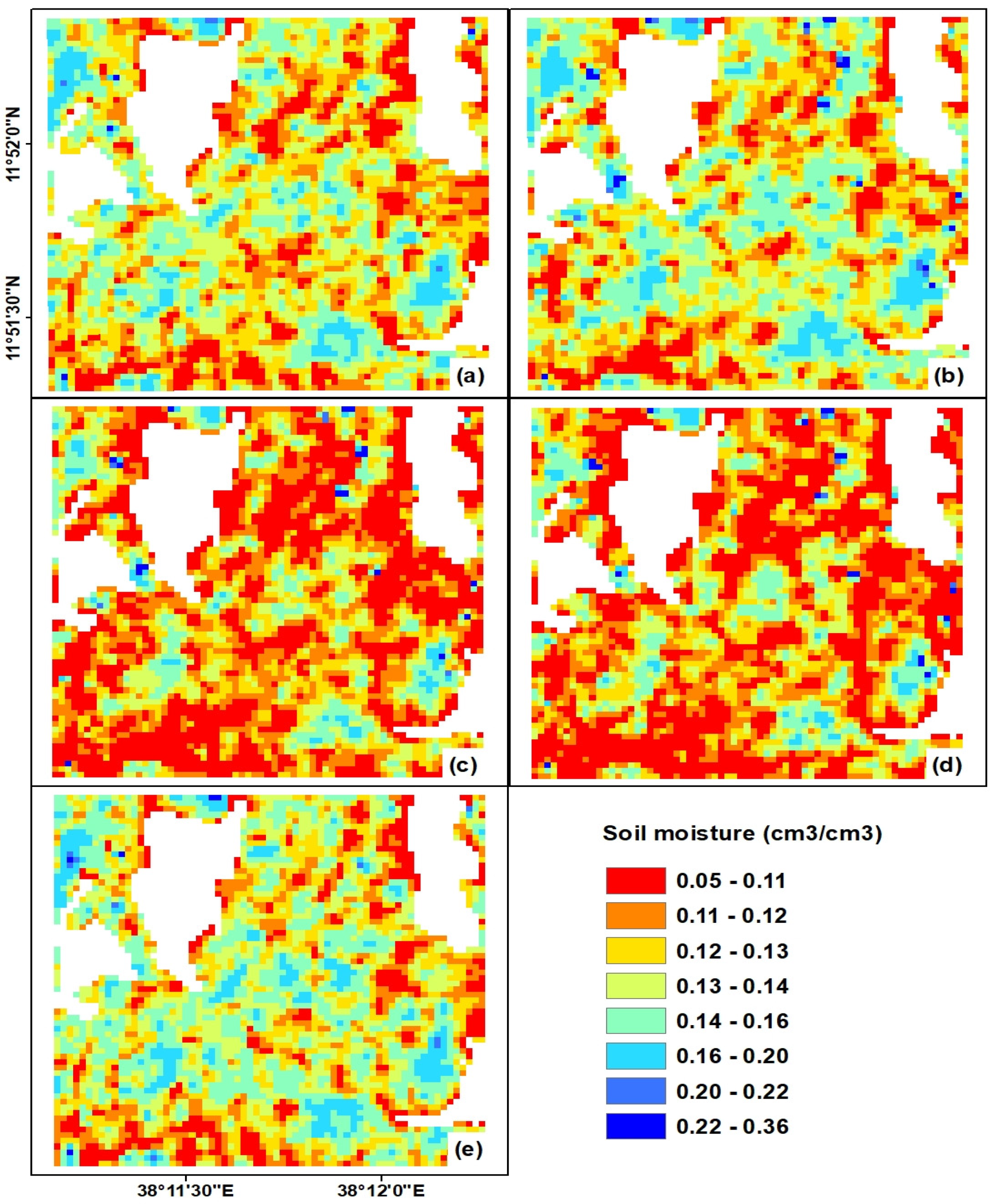
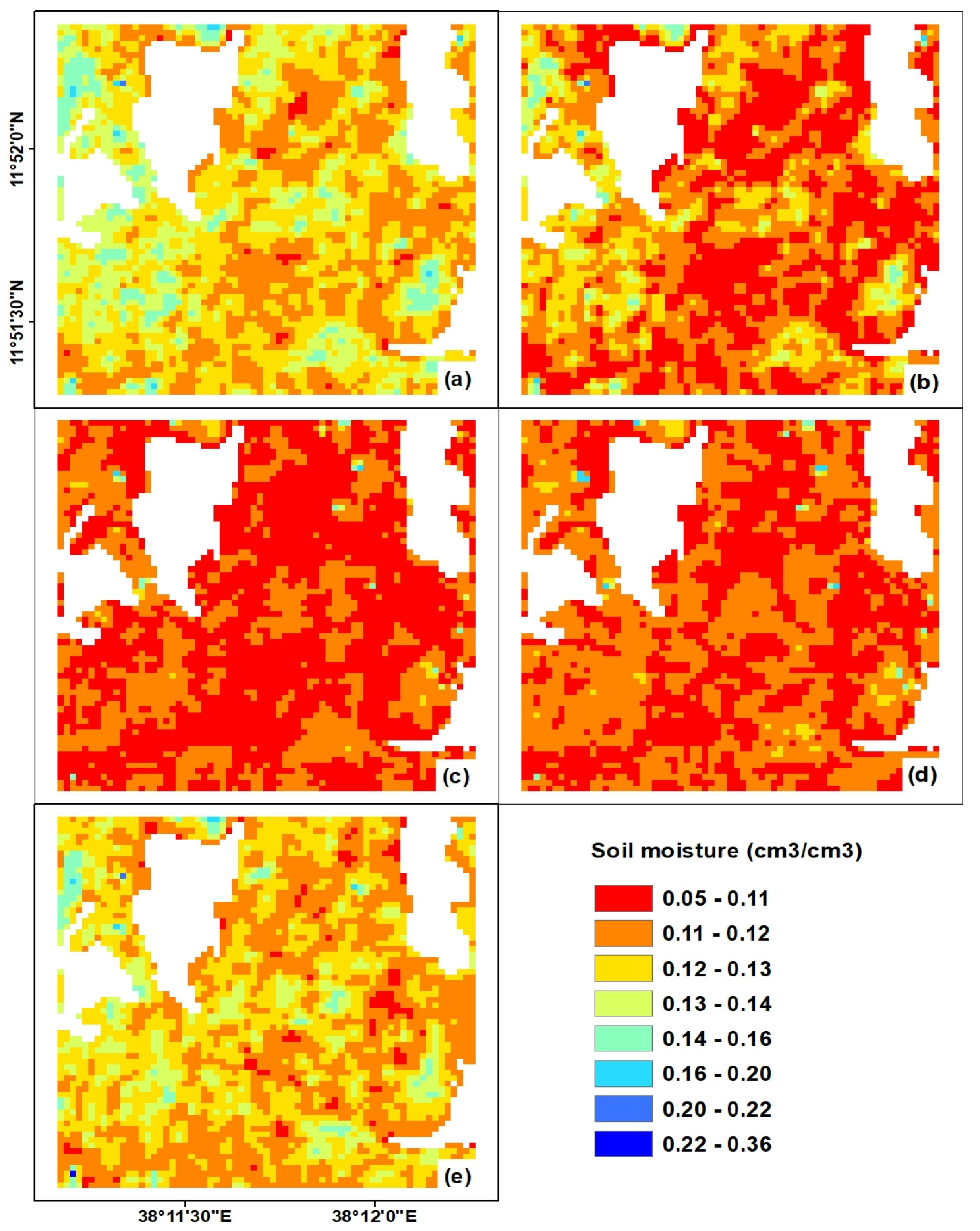
| Date of Acquisition | Acquisition Time (UTC) | Polariz. | Incidence Angle | Orbit | Product Type | |
|---|---|---|---|---|---|---|
| Start | Stop | |||||
| 22 November 2016 | 03:16:37 | 03:17:02 | VV+VH | 36.5°–39.0° | Descending | GRD |
| 29 November 2016 | 15:34:57 | 15:35:22 | VV | 35.7°–38.7° | Ascending | GRD |
| 16 December 2016 | 03:16:36 | 03:17:01 | VV+VH | 36.3°–38.9° | Descending | GRD |
| 23 December 2016 | 15:34:56 | 15:35:21 | VV | 35.7°–38.6° | Ascending | GRD |
| 2 February 2017 | 03:16:34 | 03:16:59 | VV+VH | 36.4°–39.0° | Descending | GRD |
| Date of Acquisition | Type | Sensor | Spectral Bands | Spatial Resolution (m) | Temporal Resolution (Day) |
|---|---|---|---|---|---|
| 22 November 2016 | Optical | Landsat 7 | 8 | 30 | 16 |
| 30 November 2016 | Optical | Landsat 8 | 11 | 30 | 16 |
| 16 December 2016 | Optical | Landsat 8 | 11 | 30 | 16 |
| 24 December 2016 | Optical | Landsat 7 | 8 | 30 | 16 |
| 2 February 2017 | Optical | Landsat 8 | 11 | 30 | 16 |
| Parameter | All Vegetation | Grazing Land | Crop | Grass |
|---|---|---|---|---|
| A | 0.0012 | 0.0009 | 0.0018 | 0.0014 |
| B | 0.091 | 0.032 | 0.138 | 0.084 |
| Input Variables | LRM | ANN | ||||||
|---|---|---|---|---|---|---|---|---|
| MAE | RMSE | Bias | r | MAE | RMSE | Bias | r | |
| 0.030 | 0.040 | −0.034 | 0.60 | 0.030 | 0.040 | −0.032 | 0.57 | |
| , | 0.028 | 0.038 | −0.019 | 0.70 | 0.028 | 0.036 | 0.000 | 0.67 |
| , , | 0.027 | 0.037 | 0.014 | 0.70 | 0.026 | 0.035 | −0.024 | 0.73 |
© 2020 by the authors. Licensee MDPI, Basel, Switzerland. This article is an open access article distributed under the terms and conditions of the Creative Commons Attribution (CC BY) license (http://creativecommons.org/licenses/by/4.0/).
Share and Cite
Ayehu, G.; Tadesse, T.; Gessesse, B.; Yigrem, Y.; M. Melesse, A. Combined Use of Sentinel-1 SAR and Landsat Sensors Products for Residual Soil Moisture Retrieval over Agricultural Fields in the Upper Blue Nile Basin, Ethiopia. Sensors 2020, 20, 3282. https://doi.org/10.3390/s20113282
Ayehu G, Tadesse T, Gessesse B, Yigrem Y, M. Melesse A. Combined Use of Sentinel-1 SAR and Landsat Sensors Products for Residual Soil Moisture Retrieval over Agricultural Fields in the Upper Blue Nile Basin, Ethiopia. Sensors. 2020; 20(11):3282. https://doi.org/10.3390/s20113282
Chicago/Turabian StyleAyehu, Getachew, Tsegaye Tadesse, Berhan Gessesse, Yibeltal Yigrem, and Assefa M. Melesse. 2020. "Combined Use of Sentinel-1 SAR and Landsat Sensors Products for Residual Soil Moisture Retrieval over Agricultural Fields in the Upper Blue Nile Basin, Ethiopia" Sensors 20, no. 11: 3282. https://doi.org/10.3390/s20113282
APA StyleAyehu, G., Tadesse, T., Gessesse, B., Yigrem, Y., & M. Melesse, A. (2020). Combined Use of Sentinel-1 SAR and Landsat Sensors Products for Residual Soil Moisture Retrieval over Agricultural Fields in the Upper Blue Nile Basin, Ethiopia. Sensors, 20(11), 3282. https://doi.org/10.3390/s20113282







